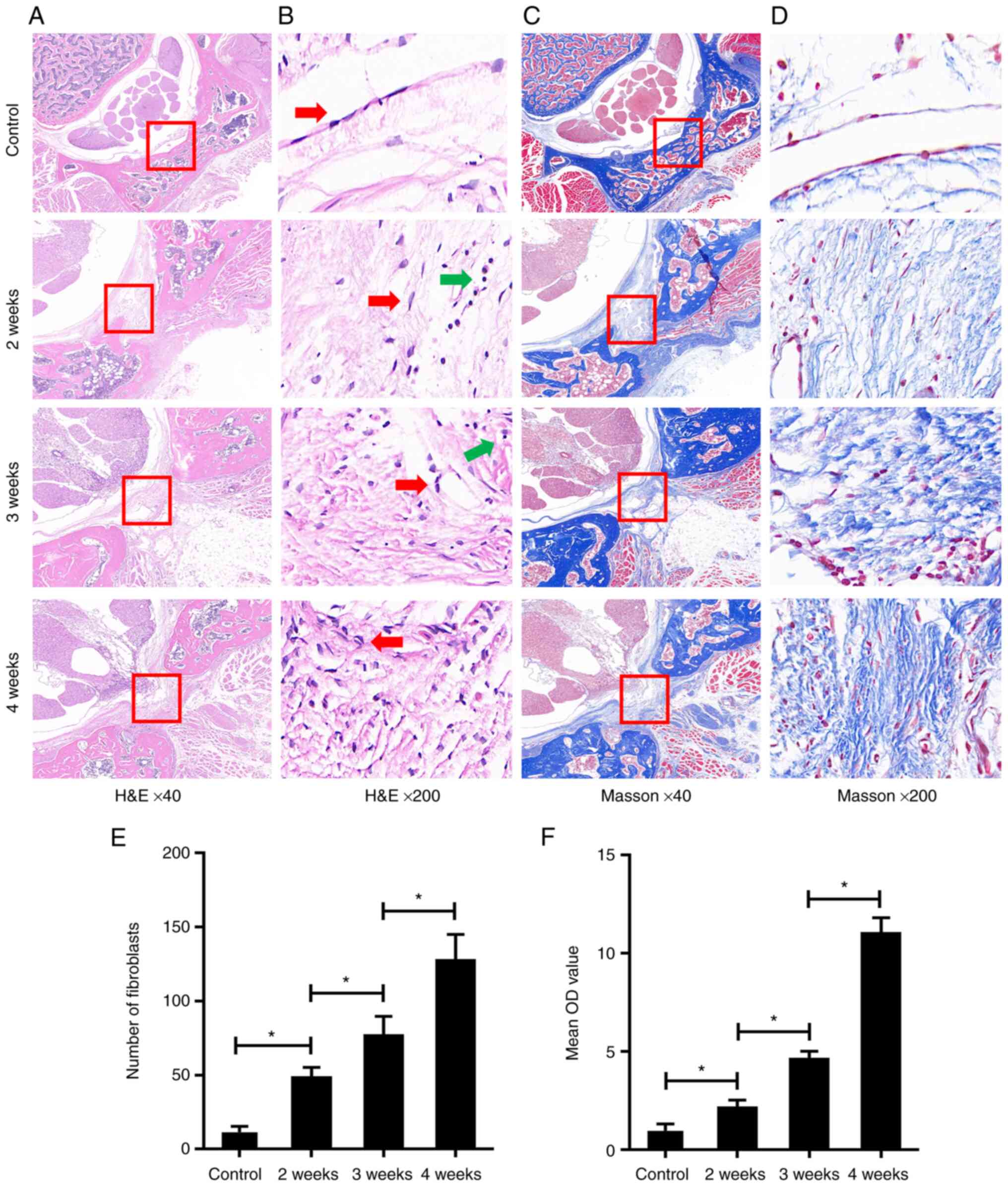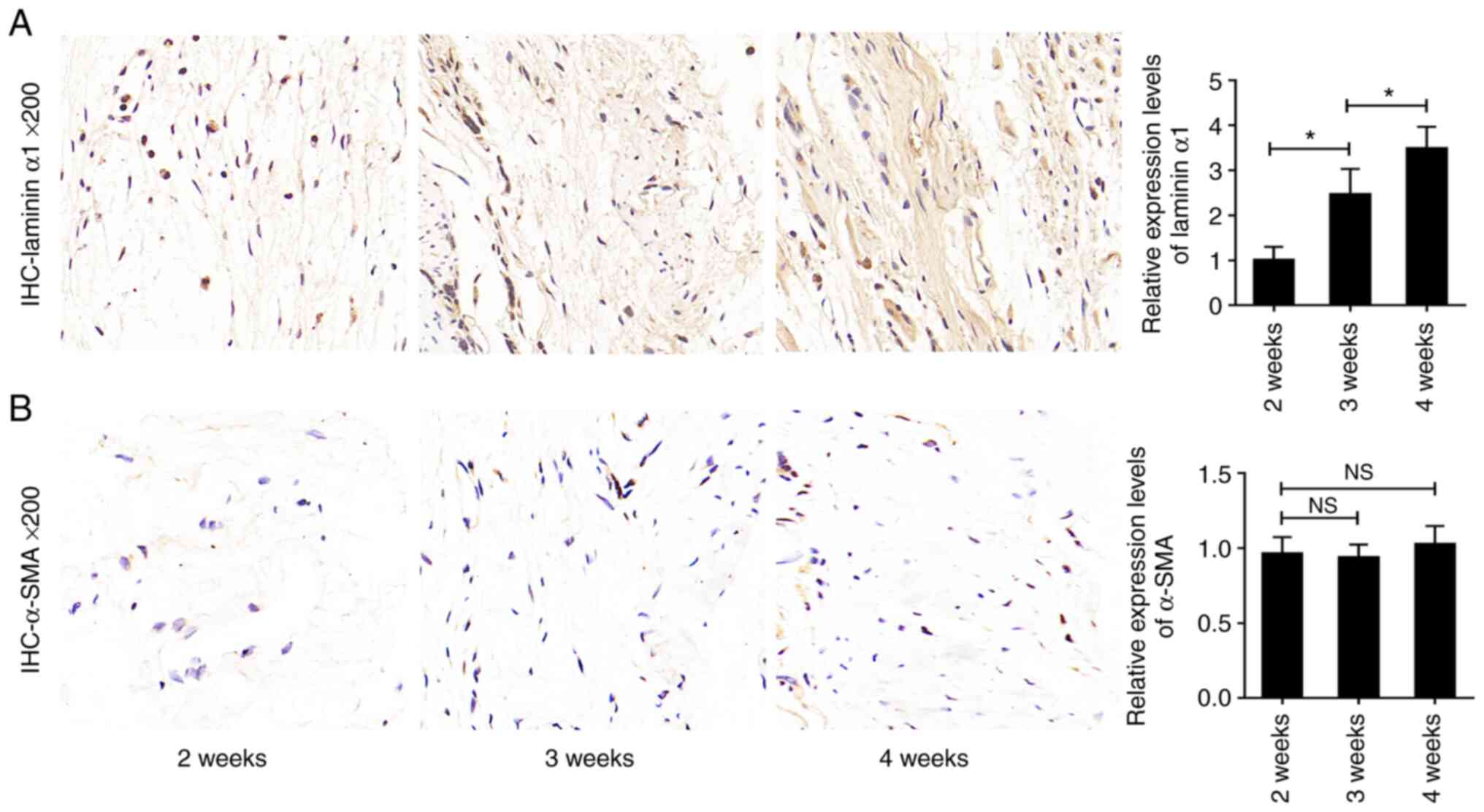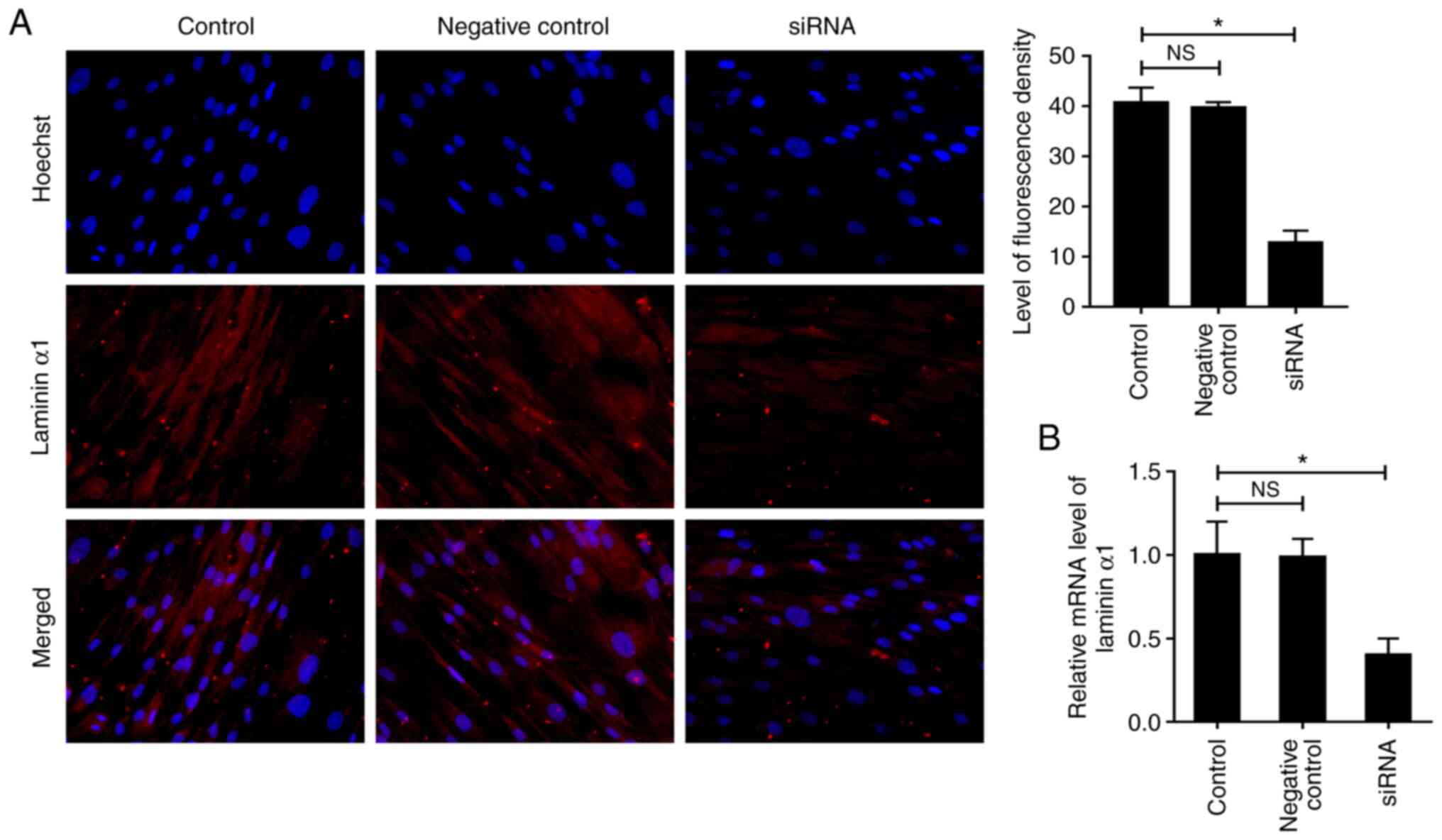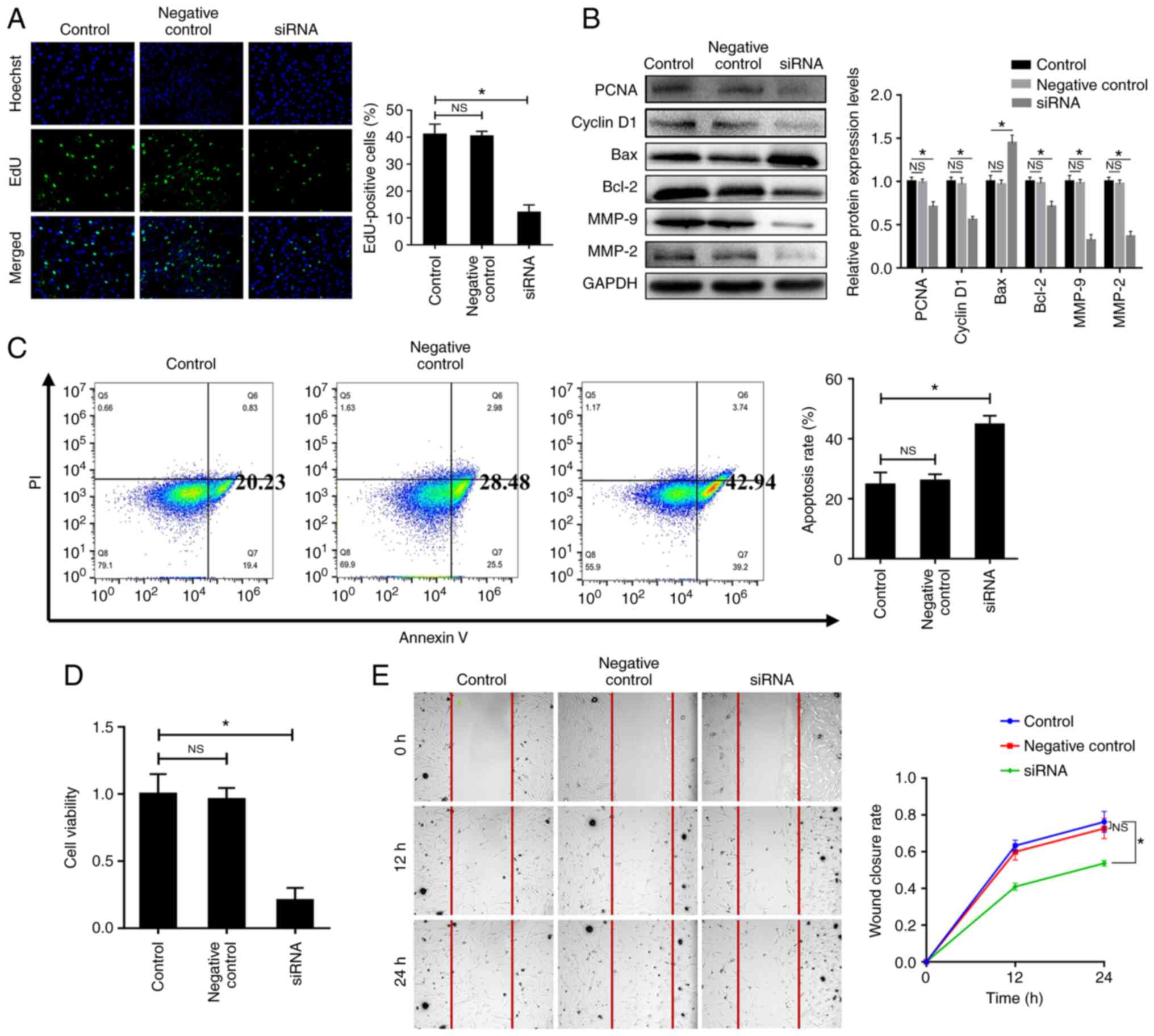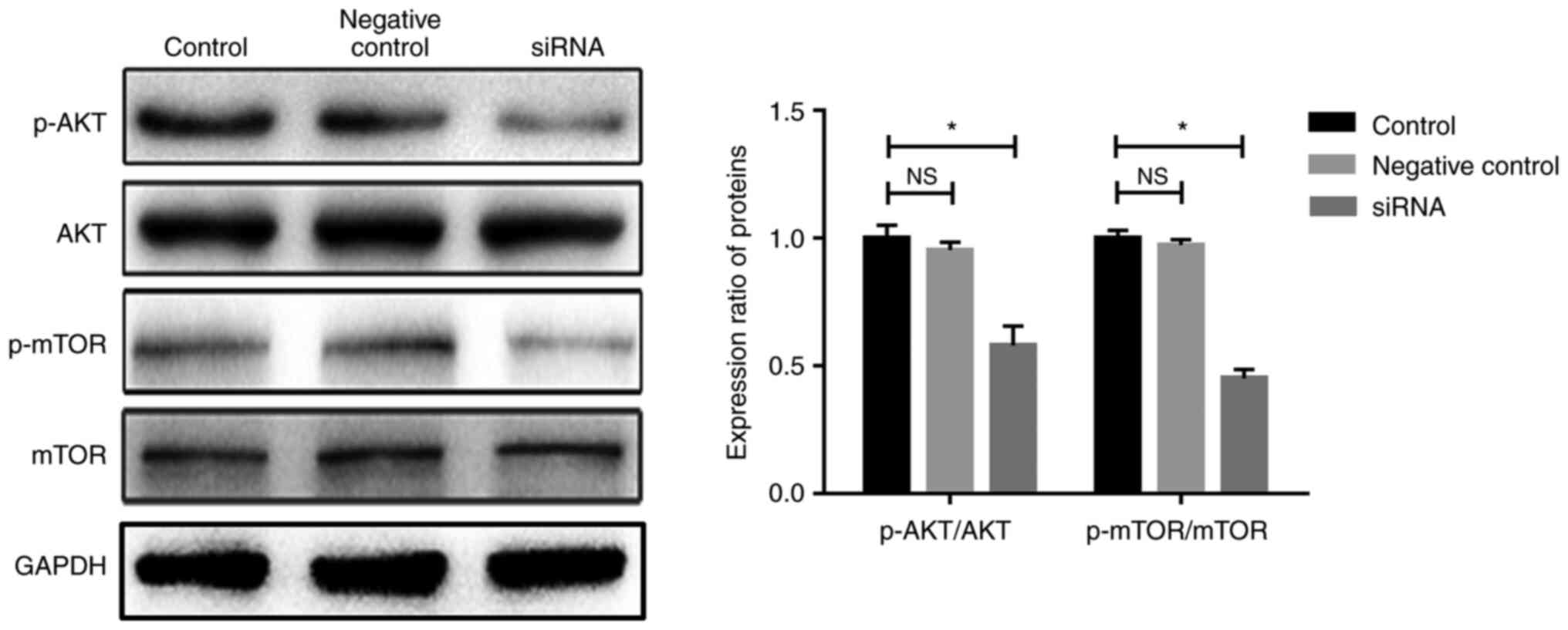|
1
|
Kong L, Shang XF, Zhang WZ, Duan LQ, Yu Y,
Ni WJ and Huang Y: Percutaneous endoscopic lumbar discectomy and
microsurgical laminotomy: A prospective, randomized controlled
trial of patients with lumbar disc herniation and lateral recess
stenosis. Orthopade. 48:157–164. 2019. View Article : Google Scholar
|
|
2
|
Sun F, Liang Q, Yan M, Wang H, Liu Z, Li
F, Dong J and Liu T: Unilateral laminectomy by endoscopy in central
lumbar canal spinal stenosis: Technical note and early outcomes.
Spine (Phila Pa 1976). 45:E871–E877. 2020. View Article : Google Scholar : PubMed/NCBI
|
|
3
|
Liu P, Chen H, Yan L and Sun Y: Laminin α5
modulates fibroblast proliferation in epidural fibrosis through the
PI3K/AKT/mTOR signaling pathway. Mol Med Rep. 21:1491–1500.
2020.PubMed/NCBI
|
|
4
|
Guyer RD, Patterson M and Ohnmeiss DD:
Failed back surgery syndrome: Diagnostic evaluation. J Am Acad
Orthop Surg. 14:534–543. 2006. View Article : Google Scholar : PubMed/NCBI
|
|
5
|
Avellanal M, Diaz-Reganon G, Orts A,
Gonzalez-Montero L and Riquelme I: Transforaminal epiduroscopy in
patients with failed back surgery syndrome. Pain Physician.
22:89–95. 2019. View Article : Google Scholar : PubMed/NCBI
|
|
6
|
Rogerson A, Aidlen J and Jenis LG:
Persistent radiculopathy after surgical treatment for lumbar disc
herniation: Causes and treatment options. Int Orthop. 43:969–973.
2019. View Article : Google Scholar
|
|
7
|
Sun Y, Zhao S, Li X, Yan L, Wang J, Wang
D, Chen H, Dai J and He J: Local application of rapamycin reduces
epidural fibrosis after laminectomy via inhibiting fibroblast
proliferation and prompting apoptosis. J Orthop Surg Res.
11:582016. View Article : Google Scholar : PubMed/NCBI
|
|
8
|
Dai J, Li X, Yan L, Chen H, He J, Wang S,
Wang J and Sun Y: The effect of suramin on inhibiting fibroblast
proliferation and preventing epidural fibrosis after laminectomy in
rats. J Orthop Surg Res. 11:1082016. View Article : Google Scholar : PubMed/NCBI
|
|
9
|
Wan Q, Chen H, Xiong G, Jiao R, Liu Y, Li
X, Sun Y, Wang J and Yan L: Artesunate protects against
surgery-induced knee arthrofibrosis by activating beclin-1-mediated
autophagy via inhibition of mTOR signaling. Eur J Pharmacol.
854:149–158. 2019. View Article : Google Scholar : PubMed/NCBI
|
|
10
|
Kikuchi K, Setoyama K, Terashi T, Sumizono
M, Tancharoen S, Otsuka S, Takada S, Nakanishi K, Ueda K, Sakakima
H, et al: Application of a novel anti-adhesive membrane, E8002, in
a rat laminectomy model. Int J Mol Sci. 19:15132018. View Article : Google Scholar : PubMed/NCBI
|
|
11
|
Chen H, Yan L, Wang J, Sun Y, Li X, Zhao
S, Wang D, Zhu G and Liang Y: Methotrexate prevents epidural
fibrosis through endoplasmic reticulum stress signalling pathway.
Eur J Pharmacol. 796:131–138. 2017. View Article : Google Scholar
|
|
12
|
Zeng L, Sun Y, Li X, Wang J and Yan L:
10-Hydroxycamptothecin induces apoptosis in human fibroblasts by
regulating miRNA-23b-3p expression. Mol Med Rep. 19:2680–2686.
2019.PubMed/NCBI
|
|
13
|
Aumailley M, Bruckner-Tuderman L, Carter
WG, Deutzmann R, Edgar D, Ekblom P, Engel J, Engvall E, Hohenester
E, Jones JC, et al: A simplified laminin nomenclature. Matrix Biol.
24:326–332. 2005. View Article : Google Scholar : PubMed/NCBI
|
|
14
|
Durbeej M: Laminins. Cell Tissue Res.
339:259–268. 2010. View Article : Google Scholar
|
|
15
|
Atsuta I, Yamaza T, Yoshinari M, Goto T,
Kido MA, Kagiya T, Mino S, Shimono M and Tanaka T: Ultrastructural
localization of laminin-5 (gamma2 chain) in the rat peri-implant
oral mucosa around a titanium-dental implant by immuno-electron
microscopy. Biomaterials. 26:6280–6287. 2005. View Article : Google Scholar : PubMed/NCBI
|
|
16
|
Sun Y, Wang TL, Toh WS and Pei M: The role
of laminins in cartilaginous tissues: From development to
regeneration. Eur Cell Mater. 34:40–54. 2017. View Article : Google Scholar : PubMed/NCBI
|
|
17
|
Yurchenco PD: Basement membranes: Cell
scaffoldings and signaling platforms. Cold Spring Harb Perspect
Biol. 3:a0049112011. View Article : Google Scholar : PubMed/NCBI
|
|
18
|
Petz M, Them NC, Huber H and Mikulits W:
PDGF enhances IRES-mediated translation of Laminin B1 by
cytoplasmic accumulation of La during epithelial to mesenchymal
transition. Nucleic Acids Res. 40:9738–9749. 2012. View Article : Google Scholar : PubMed/NCBI
|
|
19
|
Petz M, Them NC, Huber H, Beug H and
Mikulits W: La enhances IRES-mediated translation of laminin B1
during malignant epithelial to mesenchymal transition. Nucleic
Acids Res. 40:290–302. 2012. View Article : Google Scholar :
|
|
20
|
Domogatskaya A, Rodin S and Tryggvason K:
Functional diversity of laminins. Annu Rev Cell Dev Biol.
28:523–553. 2012. View Article : Google Scholar : PubMed/NCBI
|
|
21
|
Nishiuchi R, Takagi J, Hayashi M, Ido H,
Yagi Y, Sanzen N, Tsuji T, Yamada M and Sekiguchi K: Ligand-binding
specificities of laminin-binding integrins: A comprehensive survey
of laminin-integrin interactions using recombinant alpha3beta1,
alpha6beta1, alpha7beta1 and alpha6beta4 integrins. Matrix Biol.
25:189–197. 2006. View Article : Google Scholar : PubMed/NCBI
|
|
22
|
Savino W, Mendes-da-Cruz DA, Golbert DC,
Riederer I and Cotta-de-Almeida V: Laminin-mediated interactions in
thymocyte migration and development. Front Immunol. 6:5792015.
View Article : Google Scholar : PubMed/NCBI
|
|
23
|
Laperle A, Hsiao C, Lampe M, Mortier J,
Saha K, Palecek SP and Masters KS: α-5 Laminin synthesized by human
pluripotent stem cells promotes self-renewal. Stem Cell Reports.
5:195–206. 2015. View Article : Google Scholar : PubMed/NCBI
|
|
24
|
Department of Science and Technology of
Hubei Province: Regulations of Laboratory Animals of Hubei
Province. pp. 1–9. 2005, https://kjt.hubei.gov.cn/kjdt/ztzl/fzxczl/pfxcc/kjlflfg/202008/t20200826_2837541.shtml.
Accessed January 1, 2021.
|
|
25
|
Livak KJ and Schmittgen TD: Analysis of
relative gene expression data using real-time quantitative PCR and
the 2(-Delta Delta C(T)) method. Methods. 25:402–408. 2001.
View Article : Google Scholar
|
|
26
|
Han G, Nguyen LN, Macherla C, Chi Y,
Friedman JM, Nosanchuk JD and Martinez LR: Nitric oxide-releasing
nanoparticles accelerate wound healing by promoting fibroblast
migration and collagen deposition. Am J Pathol. 180:1465–1473.
2012. View Article : Google Scholar : PubMed/NCBI
|
|
27
|
Wang M, Li J, Zhang S, You Y, Zhu X, Xiang
H, Yan L, Zhao F and Li Y: Effects of titanium dioxide
nanoparticles on cell growth and migration of A549 cells under
simulated microgravity. Nanomaterials (Basel). 12:18792022.
View Article : Google Scholar : PubMed/NCBI
|
|
28
|
Yan C and Boyd DD: Regulation of matrix
metalloproteinase gene expression. J Cell Physiol. 211:19–26. 2007.
View Article : Google Scholar
|
|
29
|
Cabral-Pacheco GA, Garza-Veloz I,
Castruita-De la Rosa C, Ramirez-Acuña JM, Perez-Romero BA,
Guerrero-Rodriguez JF, Martinez-Avila N and Martinez-Fierro ML: The
roles of matrix metalloproteinases and their inhibitors in human
diseases. Int J Mol Sci. 21:97392020. View Article : Google Scholar :
|
|
30
|
Atkinson JJ and Senior RM: Matrix
metalloproteinase-9 in lung remodeling. Am J Respir Cell Mol Biol.
28:12–24. 2003. View Article : Google Scholar
|
|
31
|
Felsen CN, Savariar EN, Whitney M and
Tsien RY: Detection and monitoring of localized matrix
metalloproteinase upregulation in a murine model of asthma. Am J
Physiol Lung Cell Mol Physiol. 306:L764–L774. 2014. View Article : Google Scholar : PubMed/NCBI
|
|
32
|
Engelman JA, Luo J and Cantley LC: The
evolution of phosphatidylinositol 3-kinases as regulators of growth
and metabolism. Nat Rev Genet. 7:606–619. 2006. View Article : Google Scholar : PubMed/NCBI
|
|
33
|
Lam L, Hu X, Aktary Z, Andrews DW and
Pasdar M: Tamoxifen and ICI 182,780 increase Bcl-2 levels and
inhibit growth of breast carcinoma cells by modulating PI3K/AKT,
ERK and IGF-1R pathways independent of ERalpha. Breast Cancer Res
Treat. 118:605–621. 2009. View Article : Google Scholar
|
|
34
|
Wang S, Li X, Yan L, Nie Q, Dai J, Chen H,
Wang J and Sun Y: Tamoxifen inhibits fibroblast proliferation and
prevents epidural fibrosis by regulating the AKT pathway in rats.
Biochem Biophys Res Commun. 497:937–942. 2018. View Article : Google Scholar : PubMed/NCBI
|
|
35
|
Zheng W, Qian Y, Chen S, Ruan H and Fan C:
Rapamycin protects against peritendinous fibrosis through
activation of autophagy. Front Pharmacol. 9:4022018. View Article : Google Scholar : PubMed/NCBI
|
|
36
|
Aumailley M: The laminin family. Cell Adh
Migr. 7:48–55. 2013. View Article : Google Scholar :
|
|
37
|
Simon-Assmann P: The laminin family:
Founding members of the basement membrane. Cell Adh Migr. 7:44–47.
2013. View Article : Google Scholar :
|
|
38
|
Pozzi A, Yurchenco PD and Iozzo RV: The
nature and biology of basement membranes. Matrix Biol. 57-58:1–11.
2017. View Article : Google Scholar : PubMed/NCBI
|
|
39
|
Hynes RO: The evolution of metazoan
extracellular matrix. J Cell Biol. 196:671–679. 2012. View Article : Google Scholar : PubMed/NCBI
|
|
40
|
Kurek M, Åkesson E, Yoshihara M, Oliver E,
Cui Y, Becker M, Alves-Lopes JP, Bjarnason R, Romerius P, Sundin M,
et al: Spermatogonia loss correlates with LAMA 1 expression in
human prepubertal testes stored for fertility preservation. Cells.
10:2412021. View Article : Google Scholar : PubMed/NCBI
|
|
41
|
Hayashi H, Horinokita I, Yamada Y, Hamada
K, Takagi N and Nomizu M: Effects of laminin-111 peptide coatings
on rat neural stem/progenitor cell culture. Exp Cell Res.
400:1124402021. View Article : Google Scholar
|
|
42
|
Truong AT, Hamada K, Yamada Y, Guo H,
Kikkawa Y, Okamoto CT, MacKay JA and Nomizu M: Evaluation of
extracellular matrix mimetic laminin bioactive peptide and
elastin-like polypeptide. FASEB J. 34:6729–6740. 2020. View Article : Google Scholar : PubMed/NCBI
|
|
43
|
Carney KR, Bryan CD, Gordon HB and Kwan
KM: LongAxis: A MATLAB-based program for 3D quantitative analysis
of epithelial cell shape and orientation. Dev Biol. 458:1–11. 2020.
View Article : Google Scholar :
|
|
44
|
Lee CM, Cho SJ, Cho WK, Park JW, Lee JH,
Choi AM, Rosas IO, Zheng M, Peltz G, Lee CG and Elias JA: Laminin
α1 is a genetic modifier of TGF-β1-stimulated pulmonary fibrosis.
JCI Insight. 3:e995742018. View Article : Google Scholar
|
|
45
|
Limandjaja GC, van den Broek LJ, Breetveld
M, Waaijman T, Monstrey S, de Boer EM, Scheper RJ, Niessen FB and
Gibbs S: Characterization of in vitro reconstructed human
normotrophic, hypertrophic, and keloid scar models. Tissue Eng Part
C Methods. 24:242–253. 2018. View Article : Google Scholar : PubMed/NCBI
|
|
46
|
Nieto N and Cederbaum AI: Increased
Sp1-dependent transactivation of the LAMgamma 1 promoter in hepatic
stellate cells co-cultured with HepG2 cells overexpressing
cytochrome P450 2E1. J Biol Chem. 278:15360–15372. 2003. View Article : Google Scholar : PubMed/NCBI
|
|
47
|
Della TE, Rigamonti E, Perugino C,
Baghai-Sain S, Sun N, Kaneko N, Maehara T, Rovati L, Ponzoni M,
Milani R, et al: B lymphocytes directly contribute to tissue
fibrosis in patients with IgG4-related disease. J Allergy Clin
Immunol. 145:968–981 e14. 2020. View Article : Google Scholar
|
|
48
|
Adusei KM, Ngo TB and Sadtler K: T
lymphocytes as critical mediators in tissue regeneration, fibrosis,
and the foreign body response. Acta Biomater. 133:17–33. 2021.
View Article : Google Scholar : PubMed/NCBI
|
|
49
|
Giannandrea M and Parks WC: Diverse
functions of matrix metalloproteinases during fibrosis. Dis Model
Mech. 7:193–203. 2014. View Article : Google Scholar : PubMed/NCBI
|
|
50
|
Webb AH, Gao BT, Goldsmith ZK, Irvine AS,
Saleh N, Lee RP, Lendermon JB, Bheemreddy R, Zhang Q, Brennan RC,
et al: Inhibition of MMP-2 and MMP-9 decreases cellular migration,
and angiogenesis in in vitro models of retinoblastoma. BMC Cancer.
17:4342017. View Article : Google Scholar : PubMed/NCBI
|
|
51
|
Zhou PL, Wu Z, Zhang W, Xu M, Ren J, Zhang
Q, Sun Z and Han X: Circular RNA hsa_circ_0000277 sequesters
miR-4766-5p to upregulate LAMA1 and promote esophageal carcinoma
progression. Cell Death Dis. 12:6762021. View Article : Google Scholar : PubMed/NCBI
|
|
52
|
Chen J, Wu F, Shi Y, Yang D, Xu M, Lai Y
and Liu Y: Identification of key candidate genes involved in
melanoma metastasis. Mol Med Rep. 20:903–914. 2019.PubMed/NCBI
|
|
53
|
Mammadova-Bach E, Rupp T, Spenlé C, Jivkov
I, Shankaranarayanan P, Klein A, Pisarsky L, Méchine-Neuville A,
Cremel G, Kedinger M, et al: Laminin α1 orchestrates VEGFA
functions in the ecosystem of colorectal carcinoma. Biol Cell.
110:178–195. 2018. View Article : Google Scholar
|
|
54
|
Heng C, Lefebvre O, Klein A, Edwards MM,
Simon-Assmann P, Orend G and Bagnard D: Functional role of laminin
α1 chain during cerebellum development. Cell Adh Migr. 5:480–489.
2011. View Article : Google Scholar
|
|
55
|
Edwards MM, McLeod DS, Grebe R, Heng C,
Lefebvre O and Lutty GA: Lama1 mutations lead to vitreoretinal
blood vessel formation, persistence of fetal vasculature, and
epiretinal membrane formation in mice. BMC Dev Biol. 11:602011.
View Article : Google Scholar : PubMed/NCBI
|
|
56
|
Yang L, Cao N, Miao Y, Dai Y and Wei Z:
Morin acts as a USP7 inhibitor to hold back the migration of
rheumatoid arthritis fibroblast-like synoviocytes in a
'prickle1-mTORC2' dependent manner. Mol Nutr Food Res.
65:e21003672021. View Article : Google Scholar
|
|
57
|
Wang L, Wu T, Si C, Wang H, Yue K, Shang
S, Li X, Chen Y and Guan H: Danlou tablet activates autophagy of
vascular adventitial fibroblasts through PI3K/Akt/mTOR to protect
cells from damage caused by atherosclerosis. Front Pharmacol.
12:7305252021. View Article : Google Scholar : PubMed/NCBI
|
|
58
|
Lu Y, Zhong W, Liu Y, Chen W, Zhang J,
Zeng Z, Huang H, Qiao Y, Wan X, Meng X, et al: Anti-PD-L1 antibody
alleviates pulmonary fibrosis by inducing autophagy via inhibition
of the PI3K/Akt/mTOR pathway. Int Immunopharmacol. 104:1085042022.
View Article : Google Scholar : PubMed/NCBI
|
|
59
|
Wang S, Li X, Yan L, Chen H, Wang J and
Sun Y: Upregulation of P27Kip1 by mitomycin C induces
fibroblast apoptosis and reduces epidural fibrosis. Int J Clin Exp
Pathol. 10:11779–11788. 2017.
|
|
60
|
Dai J, Sun Y, Yan L, Wang J, Li X and He
J: Upregulation of NOXA by 10-Hydroxycamptothecin plays a key role
in inducing fibroblasts apoptosis and reducing epidural fibrosis.
PeerJ. 5:e28582017. View Article : Google Scholar : PubMed/NCBI
|
|
61
|
Tang J, Xu XY, Luo BL, Yang L, Zhang XL,
Sun YD, Hou ZQ and Yao G: Potential role of lnc-PTGS2 in fibrosis
progression after laminectomy via targeting EGR1. J Biol Regul
Homeost Agents. 34:2237–2244. 2020.PubMed/NCBI
|
|
62
|
Shi R, Huang Y, Zhang J, Wu C, Gong M,
Tian W and Zhang L: Effective delivery of mitomycin-C and meloxicam
by double-layer electrospun membranes for the prevention of
epidural adhesions. J Biomed Mater Res B Appl Biomater.
108:353–366. 2020. View Article : Google Scholar
|
|
63
|
Song Z, Wu T, Sun J, Wang H, Hua F,
Nicolas YSM, Kc R, Chen K, Jin Z, Liu J and Zhang M: Metformin
attenuates post-epidural fibrosis by inhibiting the TGF-β1/Smad3
and HMGB1/TLR4 signaling pathways. J Cell Mol Med. 25:3272–3283.
2021. View Article : Google Scholar : PubMed/NCBI
|















